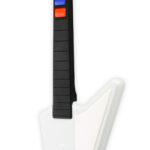Did you know that the guitar is the most sought-after instrument for children to learn? This likely comes as no surprise, especially if you’re involved in music therapy or music education. The guitar’s versatility and inherent fun factor make it incredibly appealing to kids. They are often eager to strum along to their favorite songs and create their own music, provided they receive effective and engaging instruction.
However, a significant challenge exists: the lack of a consistently effective, child-centered guitar method that guides young learners from complete beginners to confidently playing chords for their beloved songs in a way that is both enjoyable and developmentally appropriate.
In a recent episode of the Music For Kiddos Podcast, I had the pleasure of speaking with Jenna Hardy Pedersen, a seasoned educator and guitar instructor. We explored practical tips for successfully teaching guitar to kids. Our conversation also highlighted our new professional development course and success-oriented guitar curriculum specifically designed for children, aptly named Guitar For Kids.
Jenna shared her motivation behind creating Guitar For Kids, explaining, “I would search for different guitar teaching approaches and consistently come up empty. Looking at piano methods in any music store, you’d find numerous incredible options. The sheer variety was amazing… but for guitar, especially methods tailored for children, that breadth of choice simply doesn’t exist, which is quite astonishing.”
Two Essential Tips for Teaching Guitar to Kids:
-
Start with the Right Size Guitar: It’s crucial to have children begin their guitar journey using a 3/4 or even a 1/2 size classical guitar. These smaller instruments are much more comfortable for smaller bodies and hands, making the learning process physically easier and more enjoyable.
-
Emphasize Chords from the Outset: Introduce chords to children right from the beginning. This approach immediately allows them to create familiar sounds from songs they already know and love. Instead of getting bogged down in note reading and single-note melodies initially, they can experience the rewarding feeling of playing music that resonates with them.
But how can we effectively teach chords to kids whose hands might be too small to manage full-sized chord shapes? The answer lies in mini chords. These simplified chord versions utilize just the first three or four strings of the guitar. By focusing on these manageable shapes, children can quickly start playing songs that sound remarkably similar to the radio versions they are accustomed to, fostering early success and motivation.
Jenna delves deeper into her expert tips for teaching guitar to kids in episode 19 of the Music For Kiddos Podcast. Tune in to gain valuable insights into developmentally appropriate teaching strategies and discover more about our comprehensive Guitar For Kids curriculum!
Explore Guitar For Kids to preview the resources and course content!

